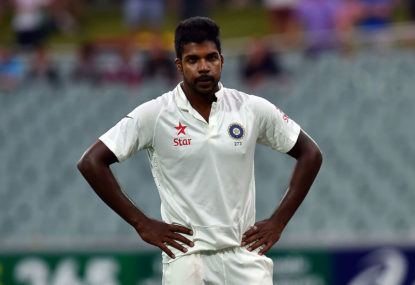Virat Kohli absolutely filthy after his wicket was upheld on controversial waist-high delivery
The Third Umpire ruled that he was standing outside his crease and the ball was dipping, making it a fair delivery - but the…

Former Indian Test spinner Harbhajan Singh has revealed that he worked hard “to earn every single wicket” of his 103-test career, and on a dustbowl pitch, “you just need to bowl fast” and “bowl in the same spot”.
While Singh is justifiably construed as antagonistic, his words should probably serve as alarm bells for Indian coach Anil Kumble.
Predicting a four-nil victory to India, Harbhajan downplayed Australian Steve O’Keefe’s record-breaking 12 wickets for 70 runs at Pune, saying O’Keefe simply benefited from India’s crumbly pitch preparation.
He also intimated that perhaps even a random spectator could have achieved the feat. “That wasn’t a pitch,” Harbhajan said to reporters. “You cannot play on such wickets where anyone runs into bowl”.
Although Australia clearly crippled that theory with 545 runs, India’s scorecard seemed to reflect Harbhajan’s sentiments – only four players managed to break a dozen runs over the entire match.
Five dropped catches also helped cement Steve Smith’s 18th Test century, with skipper Virat Kohli lamenting the team “don’t deserve to win”.
This begs the question, should Kumble – third highest wicket taker of all time – be focusing more on batting and catching practice, dustbowl style? With the captain conceding his first duck, and his team’s worst performance in two years, it may be time to acknowledge that mastering a dusty, unpredictable pitch is just as crucial to the openers as it is to the bowling attack.
Charismatic batting coach Sanjay Bangar, while credited with reviving India’s batting average after the 2014 debacle against England, has only one year’s Test match experience (12 Tests, average of 29, one century). Bangar’s work ethic and commitment to the team are without question.
Yet compared with the likes of Sachin Tendulkar (200 Tests, average of 53, 51 centuries), Bangar simply doesn’t possess the experience needed to produce batsmen capable of consistently overcoming diverse pitches and bowling styles.
Former England batsmen Michael Vaughan labelled the pitch as a “beach”, while ex teammate David Lloyd exclaiming “if that was a pitch my backside is a fire engine”.
Although Australia’s bowlers and batsmen impressively turned the tables on the home side, India must at some point be questioned on their constantly under-watered, cracked strips. Shane Warne observed on day one the Pune pitch was in an “an eighth day” condition.
The Board of Control for Cricket in India (BCCI) allegedly override advice from the Pune curator, bowing to Indian team requests to provide minimal water and remove most of the grass – both vital in binding the soil clays in extreme heat.
An interesting extract from the ICC’s ‘Pitch Monitoring Process’ suggests that should any of the following apply, a pitch may be rated ‘poor’:
a. The pitch offers excessive seam movement at any stage of the match
b. The pitch displays excessive unevenness of bounce for any bowler at any stage of the match
c. The pitch offers excessive assistance to spin bowlers, especially early in the match
d. The pitch displays little or no seam movement or turn at any stage in the match together with no significant bounce or carry, thereby depriving the bowlers of a fair contest between bat and ball.
Considering the ICC’s definition of a ‘poor’ pitch, it is difficult to recall a recent Indian pitch that would have not ticked at least two of these criteria. Of course, if visitors to the sub-continent can exploit the conditions as effectively as Australia’s latest effort, there won’t be many complaints.